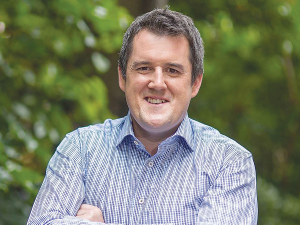Northlander Dave Gray wants to grow better heifers to improve herd fertility and production, and to milk fewer cows.
The dairy farmer of 34 years, with wife Heather, has 240ha of flat land at Awanui with 730 Jersey and Jersey-cross spring calving cows, producing just under 300,000kgMS. He runs a system 3 farm using palm kernel supplement, silage and chicory grown on 10% of the farm.
"What makes our farm different is we have measured our grass with a plate meter every 10 days for the past eight years. We have used that to focus on maximising grass growth and utilisation," Gray told a DairyNZ heifer grazing project field day at Hikurangi.
"One of the big challenges is to grow bigger heifers to improve our herd fertility and improve performance. With 730 cows through a 40-aside herringbone shed – 19 rows – that's a lot of cows to milk so that's another good reason to grow bigger heifers. We want to run the same liveweight per hectare but a lot fewer cows."
The farm's cows average 430kg; they should be 480-500kg. Ideally they would be milking 650 cows which is two rows fewer.
Rearing bigger heifers and improving herd reproduction would allow them to select the best genetics to achieve their breeding objectives. Gray says he wants their herd to be in the top 10% for BW.
Dairy heifers should calve at 90% of their genetic potential mature liveweight, an ambitious target requiring effort and focus, says Gray. Northland suffers wet winters and dry summers, facial eczema, it has low energy grass, variable pasture growth, copper and selenium deficiency and calves there wean too small.
Four years ago he was disappointed in the size of the heifers coming into the herd. With his team he formulated a plan.
They own a separate calf block of about 30ha of sandy peat. The R2 block is heavy wet clay. Italian ryegrass has been very important, doubling their carrying capacity and giving a much better winter and spring performance.
They looked at their grazing management and worked with a vet on a health plan. Out of this came a policy and procedure to achieve it.
"We want good healthy well reared calves weaned at their target weight by 10 weeks with well-developed rumen function," says Gray.
"Be wary of rearing small or sickly calves; they are much harder to rear and often a challenge to get to target weight. Late calves kept six weeks from start of calving have to grow nearly another 100g a day, so early calves are best.
"We wanted our calves shifted daily onto good quality pasture. Residuals are maintained with empty cows or a mower. These are young animals; they need to choose what they eat, you can't make them clean up pasture. Good sub-division with bay sized paddocks is ideal."
Young stock are weighed every month and entered into LIC Minda Weights program. Handling calves every month picks up problems early. Calves were falling behind growth rates in their first summer because of dry conditions and low ME grass. They feed palm kernel and silage through the summer – especially the first summer.
They have a regular drenching and health programme. When they weigh the calves each month they drench a triple combination down the throat. They supplement with selenium and copper, monitor for facial eczema and use zinc at risk periods.
They watch carefully for things like theileria or woody tongue or other problems that can retard growth. Much effort is put into avoiding pasture damage in wet periods.
In April 'something' happens all over Northland – as suggested by other Minda Weights records in the region to which Gray has access: all show the same challenge – heifers look well fed but show up as having lost weight. Now he provides PK and silage even though grass is available.
Results of their improved heifer raising programme have shown heifers born in 2012 calved almost 50kg heavier on average than previous heifers. The Jersey, Jersey-cross 2012-born heifers calved at an average of 450kg. In previous years they would have been about 400kg, says Gray.
"Those heifers are going into the herd bigger than the cows so the cows aren't going to boss them around too much. Those heifers will be around 480-500kg as mature animals."
"We are learning... we aren't right all the time but we're improving with the information from the weigh-ins and analysis charts from Minda."
Results show lactation to March 16 of the 2012-born heifers produced an average 367kg – 92% of the production of the mature cows.


















